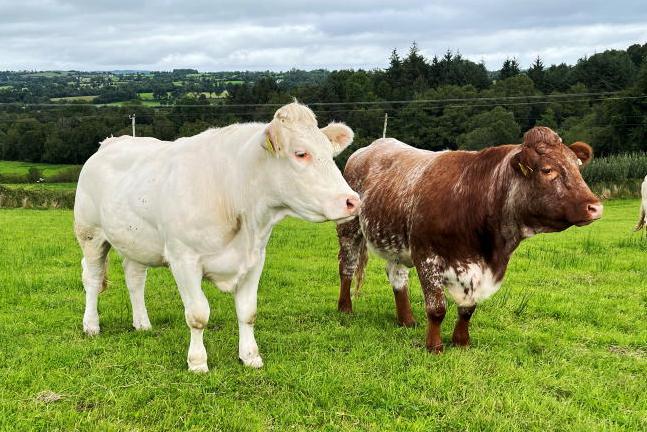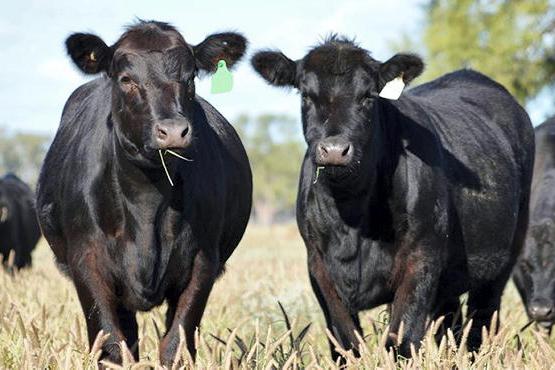Breeding policy and sire selection has been a key focus area for phase two Dairylink project farmers.
While many dairy farmers in Northern Ireland (NI) have concentrated on increasing milk yield, work carried out within the Dairylink project and the CAFRE dairy herd has shown it is possible to improve milk components and fertility while still maintaining overall output.
Recording details of sires used through milk recording has allowed project farmers to establish baseline information for a range of production parameters within their herds.
For example, Owen and James Martin have been able to generate a herd genetic report that estimated the predicted transmitting ability (PTA) of their stock for various production parameters, such as milk yield and milk components.
Shown in Figure 1 is cow PTA (protein percentage) plotted against actual protein percentage on the Martin farm. The resultant R2 value indicates the strength of the relationship, where 0 is very poor and 1 is extremely strong.With multiple factors involved, it is impossible to have a value close to 1, but the actual figure of 0.42 is still highly significant.

It suggests that using sires with higher PTA for milk protein has resulted in cows with the genetic potential to produce higher protein milk, and this is coming through in the actual milk recording results.
Similar analysis was also undertaken between cow PTA (BF percentage) and actual BF percentage (Figure 2). However, when the same exercise was carried out between cow PTA (milk yield) and actual 305-day milk yield, the results showed that the relationship in this case was very weak (R2 = 0.05). This does not mean that you can’t breed for milk yield, but it did confirm some anecdotal observations by Owen and James, who felt they had already bred animals with the potential to produce a high volume of milk.
Fertility
It is also possible to influence non production parameters through breeding decisions. For example, analysis of fertility data collected from the CAFRE dairy herd showed that cows sired by bulls with a high fertility index had better conception rates and lower calving indexes than cows sired by bulls with a low fertility index.
This in turn is backed up by evidence from Irish studies that examined the effect of using high-EBI sires on milk production and dairy herd fertility.
Genetic reports
As part of the Dairylink project, the participating farmers were encouraged to submit data through their milk recording agencies, to generate individual herd genetic reports. The results for the Martins, Richard Marshall and the CAFRE dairy herd are shown in Table 1.
The data highlights that good milk yields can still be achieved, even if the average PTA (milk) within the dairy herd is relatively low, as other factors such as feed rate have an impact on the actual production achieved.
The results also show that all the herds exhibited good genetic potential to improve BF percentage, protein percentage and fertility.
Having this baseline information allowed for the creation of sire selection criteria, to further enhance the genetic potential of subsequent crosses (Table 2).
For example, crossing an average cow in Richard Marshall’s herd with a sire that had a PTA (protein percentage) of +0.08% would produce a cross with a potential PTA (protein percentage) of +0.06%.
Certain criteria were created to select sires under the UK PLI and Irish EBI systems, to allow all project farmers to go through this exercise.
Lists of sires can be downloaded from the relevant AHDB or ICBF website and the appropriate selection filters used.
The inclusion of some genomic sires widened the pool of available sires to choose from. However, the heritability of values with genomic sires are lower than proven sires, so a wider team of genomic bulls should be selected, to manage the risk of changing values..
Long-term
Assessing the impact of breeding decisions is a long-term process. However, the creation of a herd genetic report also allows you to assess first lactation heifers within the herd and the youngstock about to enter the herd.
As shown in Table 3, youngstock on the farms all have higher PTA figures for BF percentage, protein percentage and fertility index than the respective figures quoted in Table 1.
Such improvements in genetic potential will translate into increases in milk components and reductions in calving index.
Read more
Dairylink: winter feeding the CAFRE dairy herd
Dairylink: assessing the parlour and milking routine
Breeding policy and sire selection has been a key focus area for phase two Dairylink project farmers.
While many dairy farmers in Northern Ireland (NI) have concentrated on increasing milk yield, work carried out within the Dairylink project and the CAFRE dairy herd has shown it is possible to improve milk components and fertility while still maintaining overall output.
Recording details of sires used through milk recording has allowed project farmers to establish baseline information for a range of production parameters within their herds.
For example, Owen and James Martin have been able to generate a herd genetic report that estimated the predicted transmitting ability (PTA) of their stock for various production parameters, such as milk yield and milk components.
Shown in Figure 1 is cow PTA (protein percentage) plotted against actual protein percentage on the Martin farm. The resultant R2 value indicates the strength of the relationship, where 0 is very poor and 1 is extremely strong.With multiple factors involved, it is impossible to have a value close to 1, but the actual figure of 0.42 is still highly significant.

It suggests that using sires with higher PTA for milk protein has resulted in cows with the genetic potential to produce higher protein milk, and this is coming through in the actual milk recording results.
Similar analysis was also undertaken between cow PTA (BF percentage) and actual BF percentage (Figure 2). However, when the same exercise was carried out between cow PTA (milk yield) and actual 305-day milk yield, the results showed that the relationship in this case was very weak (R2 = 0.05). This does not mean that you can’t breed for milk yield, but it did confirm some anecdotal observations by Owen and James, who felt they had already bred animals with the potential to produce a high volume of milk.
Fertility
It is also possible to influence non production parameters through breeding decisions. For example, analysis of fertility data collected from the CAFRE dairy herd showed that cows sired by bulls with a high fertility index had better conception rates and lower calving indexes than cows sired by bulls with a low fertility index.
This in turn is backed up by evidence from Irish studies that examined the effect of using high-EBI sires on milk production and dairy herd fertility.
Genetic reports
As part of the Dairylink project, the participating farmers were encouraged to submit data through their milk recording agencies, to generate individual herd genetic reports. The results for the Martins, Richard Marshall and the CAFRE dairy herd are shown in Table 1.
The data highlights that good milk yields can still be achieved, even if the average PTA (milk) within the dairy herd is relatively low, as other factors such as feed rate have an impact on the actual production achieved.
The results also show that all the herds exhibited good genetic potential to improve BF percentage, protein percentage and fertility.
Having this baseline information allowed for the creation of sire selection criteria, to further enhance the genetic potential of subsequent crosses (Table 2).
For example, crossing an average cow in Richard Marshall’s herd with a sire that had a PTA (protein percentage) of +0.08% would produce a cross with a potential PTA (protein percentage) of +0.06%.
Certain criteria were created to select sires under the UK PLI and Irish EBI systems, to allow all project farmers to go through this exercise.
Lists of sires can be downloaded from the relevant AHDB or ICBF website and the appropriate selection filters used.
The inclusion of some genomic sires widened the pool of available sires to choose from. However, the heritability of values with genomic sires are lower than proven sires, so a wider team of genomic bulls should be selected, to manage the risk of changing values..
Long-term
Assessing the impact of breeding decisions is a long-term process. However, the creation of a herd genetic report also allows you to assess first lactation heifers within the herd and the youngstock about to enter the herd.
As shown in Table 3, youngstock on the farms all have higher PTA figures for BF percentage, protein percentage and fertility index than the respective figures quoted in Table 1.
Such improvements in genetic potential will translate into increases in milk components and reductions in calving index.
Read more
Dairylink: winter feeding the CAFRE dairy herd
Dairylink: assessing the parlour and milking routine











SHARING OPTIONS